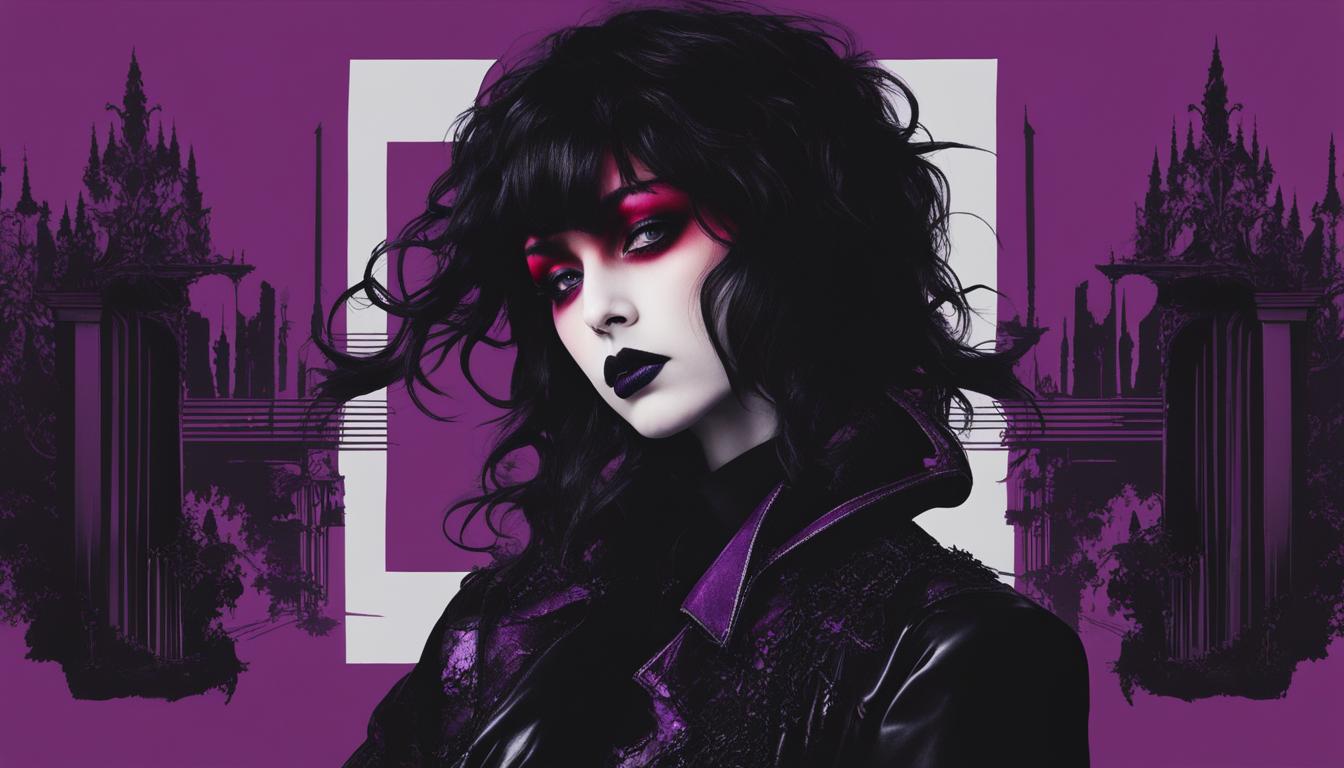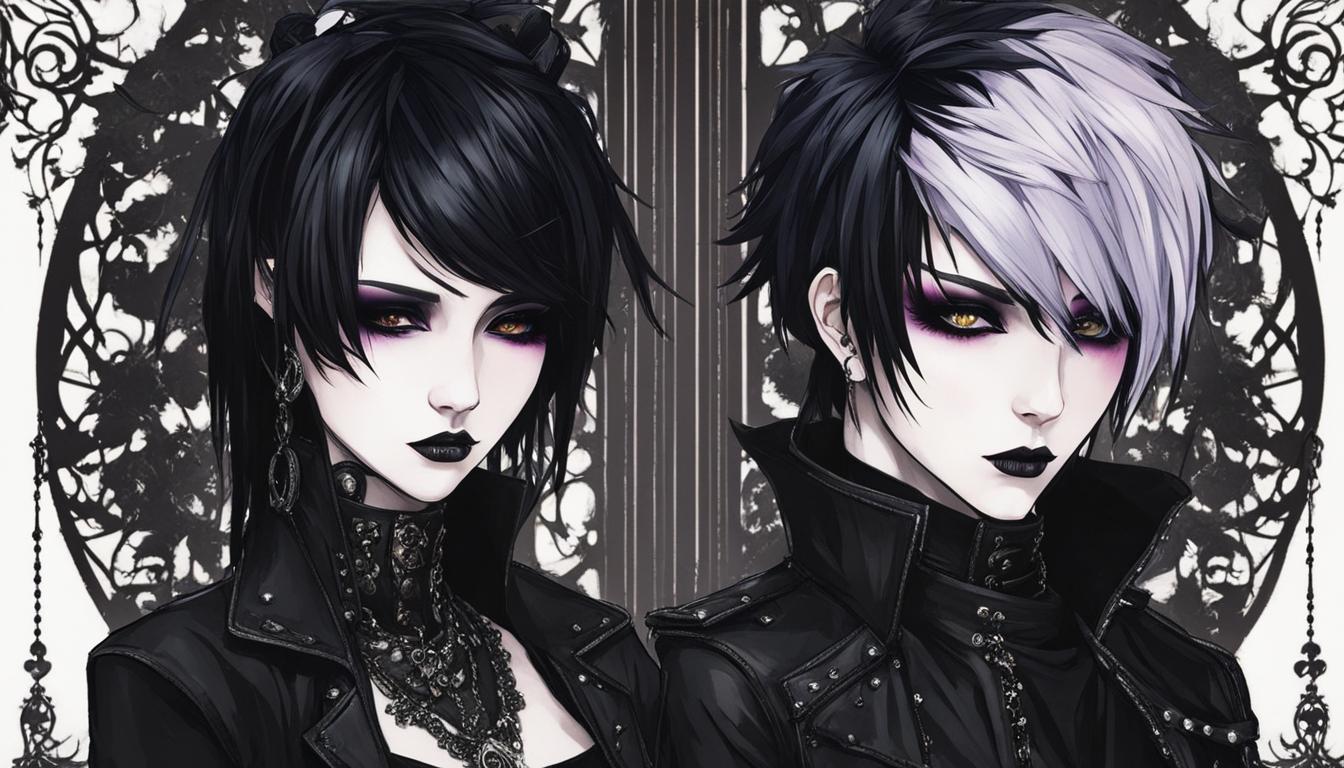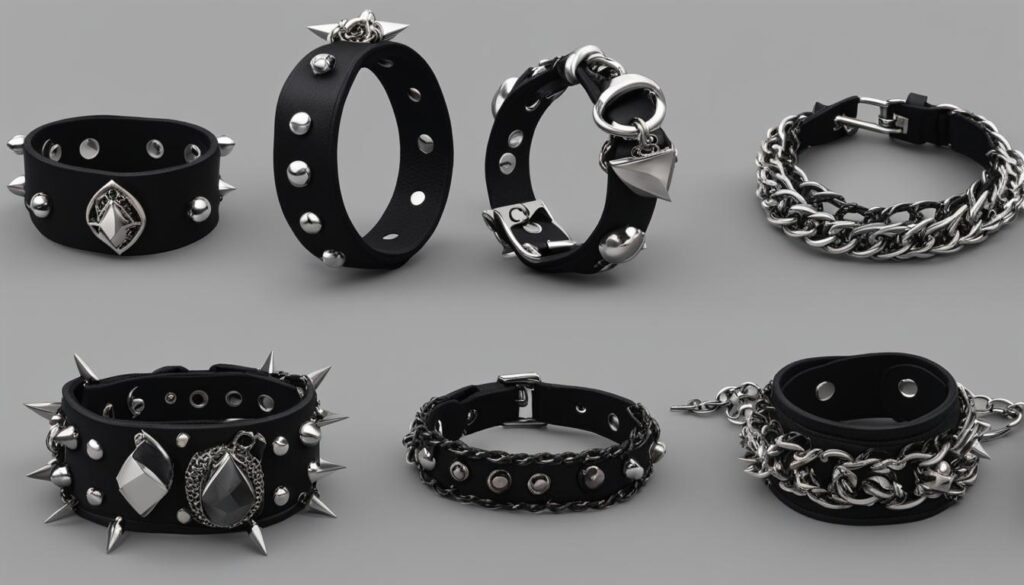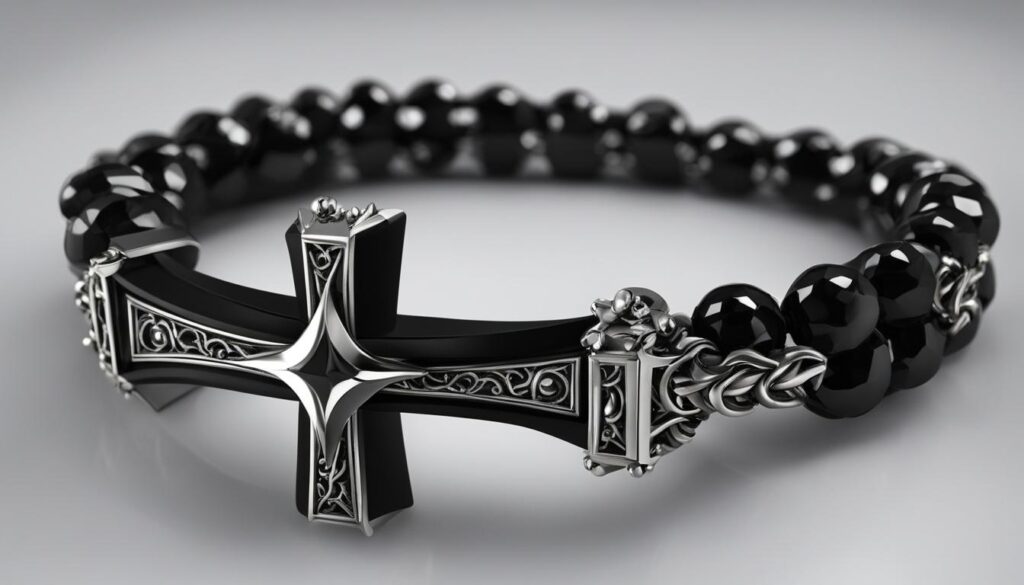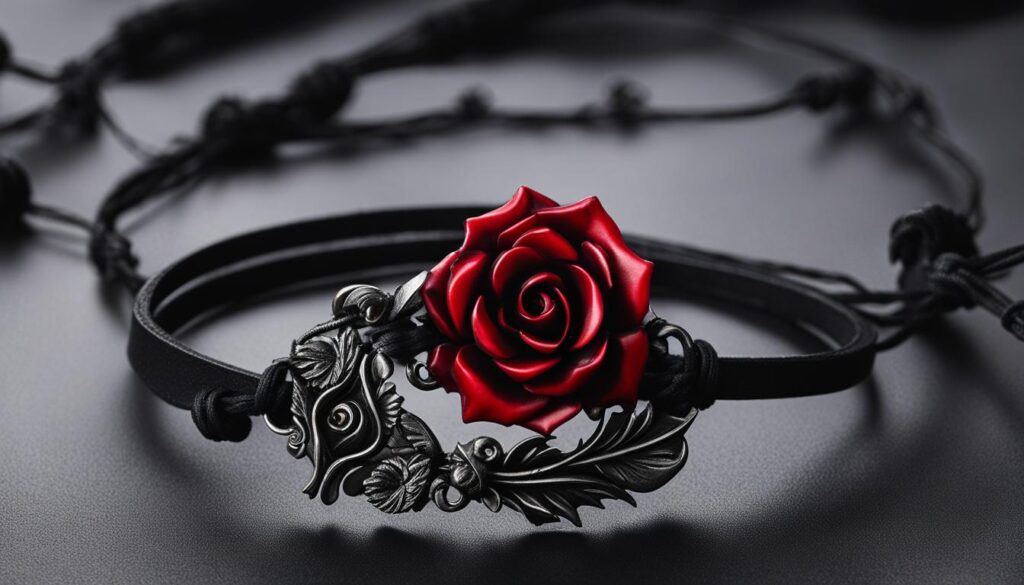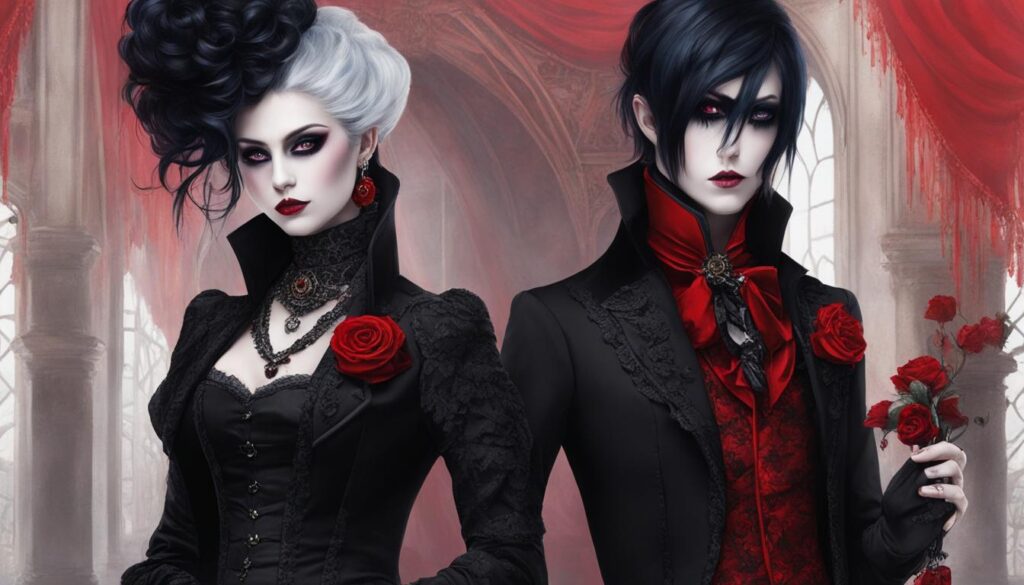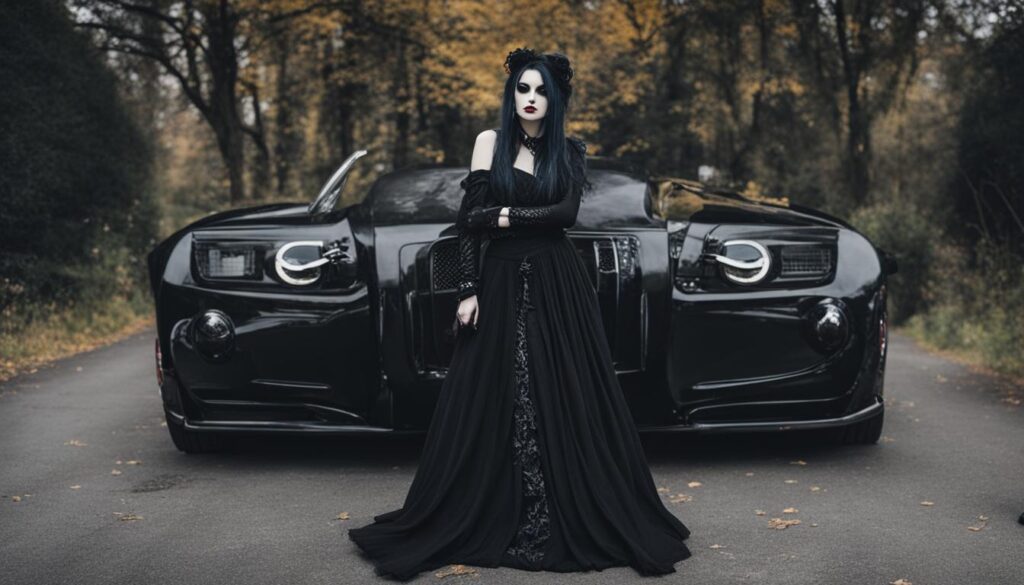Welcome to our in-depth exploration of goth music, a subgenre of post-punk that emerged in the late 1970s and early 1980s in the United Kingdom. With its dark and melancholic lyrics, atmospheric soundscapes, and introspective themes, goth music has captivated audiences for decades. In this article, we will delve into the origins, key bands, characteristics, fashion, and culture surrounding goth music. Join us on this journey through the haunting melodies and enigmatic allure of goth music.
Key Takeaways
- Goth music is a subgenre of post-punk that emerged in the late 1970s and early 1980s.
- Goth music is characterized by its dark and melancholic lyrics, atmospheric soundscapes, and introspective themes.
- The term “goth” originally referred to a Germanic tribe but later became associated with a subculture of music fans.
- Bauhaus is widely considered the first goth band, known for their debut single “Bela Lugosi’s Dead”.
- Goth culture embraces individuality, nonconformity, and a fascination with the dark and mysterious.
The Origins and Characteristics of Goth Music
Goth music, a subgenre of post-punk, emerged in the late 1970s and early 1980s in the United Kingdom. It was heavily influenced by punk and post-punk, but it developed its own unique characteristics that set it apart. Goth music is characterized by its dark and melancholic lyrics, atmospheric soundscapes, and introspective themes.
Influenced by punk’s DIY ethos and preference for outcast themes, goth music took on a slower and more introspective sound. While punk was associated with fast, aggressive music and political protest, goth music delved into personal themes like love, loss, and death. The music often features atmospheric soundscapes created by keyboards, synthesizers, and effects pedals. The guitar riffs are simple yet effective, creating a mesmerizing wall of sound. Drumming is slow and deliberate, building tension rather than focusing on fast beats.
Overall, goth music explores dark subject matter and delves into the realms of the supernatural and the macabre. It draws inspiration from gothic literature and horror films, taking cues from the likes of Edgar Allan Poe, H.P. Lovecraft, and Bram Stoker. The genre’s introspective lyrics and atmospheric soundscapes create a haunting and captivating musical experience for its listeners.
Goth Music Characteristics:
- Dark and melancholic lyrics
- Atmospheric soundscapes created by keyboards, synthesizers, and effects pedals
- Simple yet effective guitar riffs that create a wall of sound
- Slow and deliberate drumming, building tension
- Exploration of dark themes such as death, despair, and the supernatural
- Inspiration from gothic literature and horror films
Key Bands in Goth Music
Goth music has been shaped by several key bands that have become synonymous with the genre. These bands have not only influenced the sound and style of goth music but have also played a crucial role in defining the aesthetic and ethos of the subculture.
One of the most pivotal and influential bands in goth music is Bauhaus. Known for their dark and atmospheric sound, Bauhaus is widely recognized as the first goth band. Their iconic debut single “Bela Lugosi’s Dead” set the tone for the genre and continues to be a goth anthem. Bauhaus paved the way for other bands to explore the boundaries of goth music.
The Cure is another key band that emerged from the goth music scene. With their introspective lyrics and distinctive sound, The Cure became one of the most successful and enduring acts in goth music. Their albums like “Disintegration” and “Pornography” are considered classics of the genre.
Siouxsie and the Banshees also played a crucial role in shaping goth music. Led by the enigmatic Siouxsie Sioux, the band combined elements of punk, post-punk, and goth to create a unique and captivating sound. Their albums like “Juju” and “Kaleidoscope” showcased their versatility and experimental spirit.
Sisters of Mercy is another notable band in goth music. With their brooding sound, intense lyrics, and powerful performances, Sisters of Mercy captivated audiences and solidified their place in the goth music scene. Their album “First and Last and Always” remains a goth music classic.
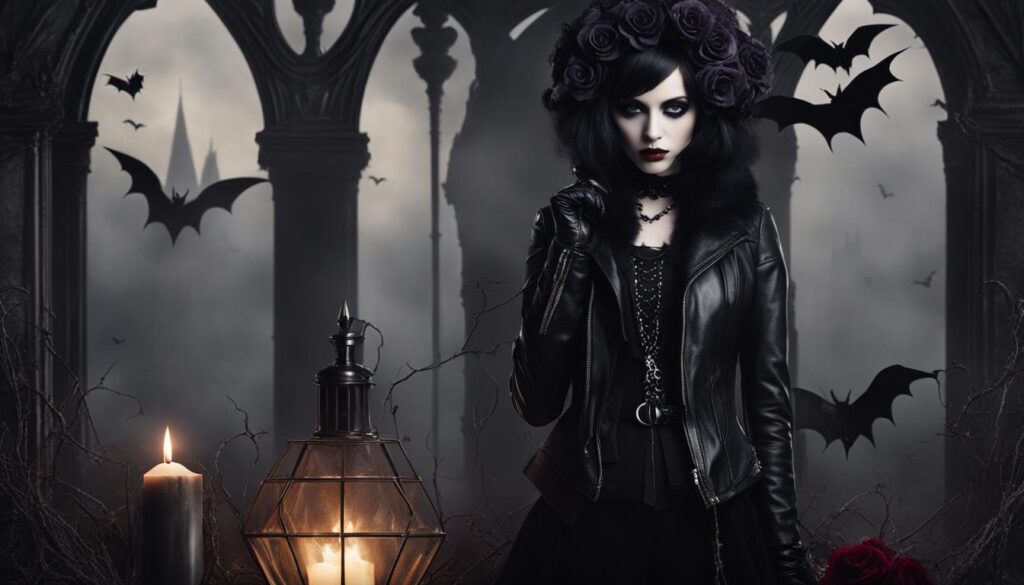
These key bands have not only contributed to the evolution and growth of goth music but have also left an indelible mark on the subculture. Their influence can be seen in the music, fashion, and overall aesthetic of goth culture. As goth music continues to evolve, these key bands remain pillars of the genre and continue to inspire new generations of musicians and fans.
Characteristics of Goth Music
Goth music is known for its distinct characteristics that set it apart from other genres. From its atmospheric soundscapes to its introspective lyrics and dark subject matter, goth music captivates listeners with its unique mood and style.
Atmospheric Soundscapes
A defining feature of goth music is its use of atmospheric soundscapes. Keyboards, synthesizers, and effects pedals create layers of haunting melodies and ethereal textures that envelop the listener. These atmospheric elements contribute to the immersive and introspective nature of goth music.
Introspective Lyrics
Goth music explores deeply personal and introspective themes in its lyrics. Artists delve into topics such as death, despair, love, and loss, often drawing inspiration from gothic literature and horror films. The introspective nature of the lyrics allows listeners to connect on a profound emotional level.
Dark Subject Matter
Dark subject matter is another defining characteristic of goth music. Artists often draw inspiration from the supernatural, gothic literature, and the macabre. The lyrics delve into the depths of human emotions, exploring themes that are often considered taboo in mainstream music.
Overall, goth music is a genre that embraces the darkness and explores the complexities of the human experience. It creates a unique sonic landscape with its atmospheric soundscapes, introspective lyrics, and exploration of dark subject matter.
The Fashion and Aesthetic of Goth Music
Goth music is not just about the sound, but also about the fashion and aesthetic that accompanies it. The goth fashion scene is known for its dark, dramatic, and often extravagant style. Black clothing is a staple, with goths often embracing layers, lace, and leather. The goth aesthetic draws inspiration from various influences, including Victorian and medieval fashion, as well as elements of punk and post-punk styles.
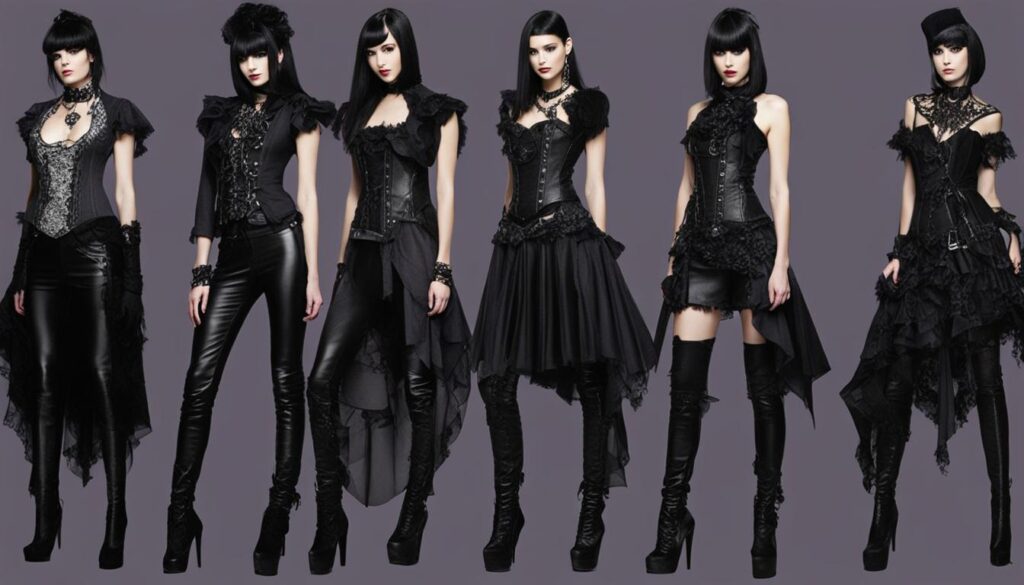
Goth fashion has had a significant influence on mainstream fashion, with its bold and daring looks making appearances on runways and in magazines. Designers like Alexander McQueen and Vivienne Westwood have been inspired by goth fashion, incorporating its dark and edgy elements into their collections. Goth music’s influence on fashion can also be seen in the rise of alternative clothing brands that cater specifically to the goth subculture.
The goth aesthetic goes beyond just clothing and extends to makeup and hairstyles as well. Pale skin, dark eye makeup, and bold lipstick are often favored by goths, creating a striking and dramatic look. Hairstyles range from sleek and straight to elaborate and voluminous, with colors ranging from jet black to vibrant shades of purple and red.
Gothic Literature and Film Influences
- Gothic literature and horror films have played a significant role in shaping the goth aesthetic. Works by authors such as Edgar Allan Poe, Mary Shelley, and Bram Stoker have inspired goths with their dark and macabre themes.
- Horror films like Nosferatu, The Cabinet of Dr. Caligari, and The Crow have influenced the visual style and atmosphere of goth music and fashion.
- The goth subculture often incorporates references to these literary and cinematic influences, creating a rich tapestry of dark and intriguing imagery.
“Goth fashion is a visual expression of the music and literature that inspires the subculture, creating a unique and captivating aesthetic.”
Overall, the fashion and aesthetic of goth music play a crucial role in defining the subculture. It is a visual expression of the music and literature that inspires the goth community, creating a unique and captivating aesthetic. From the black clothing to the dark makeup and hairstyles, goth fashion continues to be a powerful form of self-expression for individuals within the goth subculture.
Influences on Goth Music
Goth music has been heavily influenced by the punk and post-punk movements, which played a significant role in shaping the genre. The punk movement, with bands like The Sex Pistols, The Damned, and The Clash, introduced a sense of rebellion and DIY ethos that resonated with the goth subculture. The fast and aggressive music of punk contrasted with the slower, introspective sound of goth, but both shared a sense of nonconformity and a desire to challenge societal norms.
Post-punk bands such as Joy Division and Siouxsie and the Banshees further contributed to the development of goth music. These bands introduced experimental sounds and introspective lyrics, exploring themes of love, loss, and existential dread. Post-punk’s dark and atmospheric soundscapes provided a foundation for the goth genre, influencing the use of keyboards, synthesizers, and effects pedals in goth music.
Goth Music: Evolution and Subgenres
Goth music has evolved over the years, branching out into various subgenres and influencing multiple musical styles. One notable subgenre that emerged in the early 1990s is gothic metal. Combining elements of goth rock and heavy metal, gothic metal brought a darker and heavier sound to the genre. Bands like Paradise Lost, Type O Negative, and Theatre of Tragedy embraced the gothic aesthetic while incorporating deep, growling vocals and heavier guitar riffs. Gothic metal continues to attract a dedicated fanbase and remains a prominent subgenre within the goth music scene.
Another subgenre influenced by goth music is darkwave. Darkwave emerged in the 1980s as a synth-based genre characterized by its ethereal soundscapes and introspective lyrics. Artists like Clan of Xymox, Cocteau Twins, and Dead Can Dance blended elements of goth rock, new wave, and electronic music to create a haunting and atmospheric sound. Darkwave has since evolved and diversified, with artists incorporating elements of industrial, ambient, and trip-hop into their music.
Within the realm of goth music, subgenres like ethereal wave, post-punk revival, and dark cabaret have also emerged. Ethereal wave combines goth aesthetics with ethereal vocals and dreamy soundscapes, while post-punk revival seeks to recreate the sound and style of the original post-punk bands that influenced goth music. Dark cabaret takes inspiration from vaudeville and burlesque, combining goth aesthetics with elements of dark comedy and theatrical performances.
The evolution of goth music and the emergence of various subgenres have allowed artists to explore new sounds and push the boundaries of the genre. This ongoing evolution ensures that goth music remains a vibrant and dynamic part of the alternative music scene today.
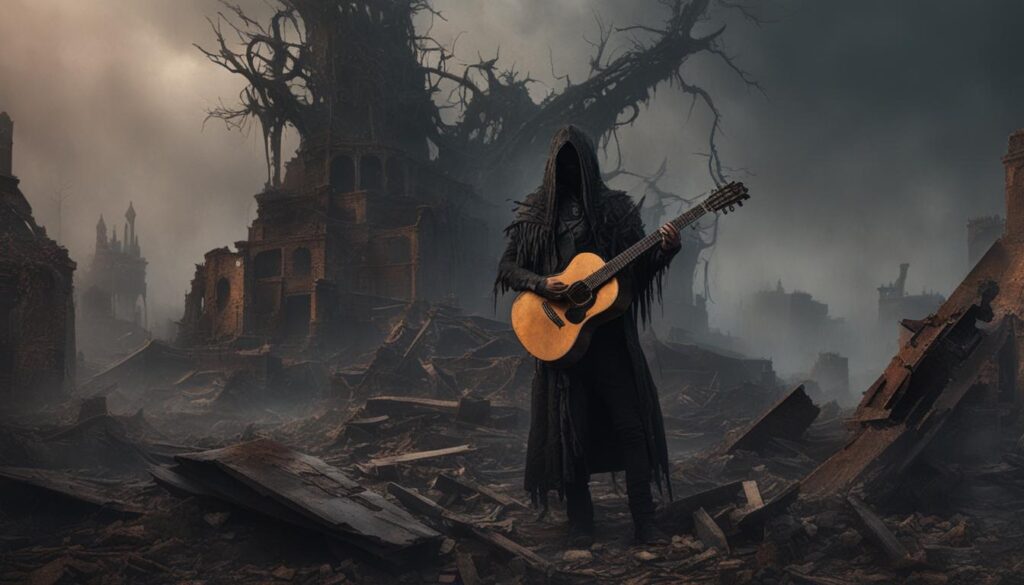
The Evolution of Goth Music: Key Points
- Goth music has evolved over time, branching out into various subgenres.
- Gothic metal emerged in the early 1990s, combining goth rock with heavy metal.
- Darkwave is a synth-based subgenre characterized by ethereal soundscapes and introspective lyrics.
- Ethereal wave, post-punk revival, and dark cabaret are other subgenres within the goth music scene.
Modern Goth Music
Goth music, with its dark and introspective themes, continues to evolve and inspire new generations of musicians. The contemporary goth scene features a diverse range of artists who bring their own unique twists to the genre, maintaining its powerful force in the world of alternative music.
Two prominent names in modern goth music are Chelsea Wolfe and Drab Majesty. Chelsea Wolfe is known for her haunting vocals and atmospheric soundscapes that blend elements of goth, folk, and metal. Her music explores themes of darkness, romance, and the occult, creating a captivating and immersive experience for listeners. With albums like “Abyss” and “Hiss Spun,” Wolfe has established herself as a leading figure in the modern goth scene.
Drab Majesty, on the other hand, takes a more synth-driven approach to goth music. The project, fronted by Deb Demure, combines elements of post-punk, new wave, and shoegaze to create a dreamy and ethereal sound. Drab Majesty’s music is often introspective and introspective, exploring themes of identity, isolation, and nostalgia. Albums like “The Demonstration” and “Modern Mirror” have garnered critical acclaim and solidified Drab Majesty’s place in modern goth music.
These contemporary goth bands, along with many others, are pushing the boundaries of the genre and ensuring its longevity. Through their music, they evoke the spirit of goth culture and maintain its relevance in today’s ever-changing music landscape.
The Enigmatic World of Goth Culture
Goth culture is a captivating subculture that embraces the unconventional and celebrates individuality. It is a world shrouded in darkness and mystery, characterized by its unique fashion, music, and sense of community.
At the heart of goth culture is its distinctive style, which often revolves around a love for black clothing and accessories. Goths embrace a fashion aesthetic that draws inspiration from Victorian and medieval eras, incorporating elements of romanticism and decadence. From flowing lace dresses to leather jackets and platform boots, goth fashion allows individuals to express their personality and creativity.
The goth subculture is not solely defined by its fashion, however. It is a community that fosters a deep appreciation for art, literature, and music that explores dark and introspective themes. Goths find solace and inspiration in the works of poets like Edgar Allan Poe and authors like Anne Rice. Music is another vital aspect of goth culture, with goth bands such as Bauhaus, The Cure, and Siouxsie and the Banshees providing the soundtrack to this unique subculture.
What truly sets goth culture apart is its strong sense of community. Goths often come together in events, clubs, and online forums, where they can share their interests, experiences, and love for all things dark. This sense of belonging provides goths with a supportive and understanding network, fostering a sense of acceptance and camaraderie.

Goth Culture: Embracing the Enigma
Goth culture is a world of enigma, where darkness and creativity intertwine. It’s a subculture that allows individuals to explore their innermost thoughts and emotions, challenging societal norms and embracing a different way of thinking. Whether through fashion, music, or art, goth culture continues to captivate and inspire those who dare to delve into its mysterious depths.
Goth Culture as a Mindset: Embracing Self-Expression and Acceptance
Goth culture is more than just a fashion statement or a style of music – it is a mindset and a way of thinking. At its core, goth culture is about celebrating self-expression, individualism, and nonconformity. Goths value the freedom to express themselves authentically, embracing their unique identities and rejecting societal norms that may try to stifle their creativity.
One of the key values of goth culture is self-expression. Goths use fashion, music, art, and other forms of creative expression to convey their inner thoughts, emotions, and identities. The goth aesthetic, with its dark and dramatic style, serves as a powerful visual symbol of this self-expression. Goths often seek out alternative and unconventional ways to express themselves, whether it’s through poetry, visual art, or even body modifications.
Acceptance is another important value within goth culture. Goths embrace diversity and inclusivity, creating a welcoming and accepting community where individuals can truly be themselves. This acceptance extends beyond just appearance or lifestyle choices; it encompasses a deep respect for different beliefs, perspectives, and experiences. Goths understand that everyone’s journey is unique, and they celebrate the beauty of diversity within their community.
Ultimately, goth culture emphasizes the power of individuality and the right to be different. It encourages people to explore their own dark and mysterious nature, unafraid to delve into the depths of their own thoughts and emotions. Through self-expression and acceptance, goth culture provides a space for like-minded individuals to connect and find solace in their shared love for the unconventional.
Goth Culture and Music
The world of goth culture is intrinsically intertwined with music. Goth music serves as a defining aspect of goth culture, shaping its fashion, aesthetics, and values. With its dark and introspective themes, goth music creates a sense of unity among goths and provides a soundtrack to the goth lifestyle.
Goth music has had a profound impact on goth fashion, influencing the way goths dress and express themselves. The haunting melodies and melancholic lyrics of goth music have inspired a distinct visual style, characterized by black clothing, heavy makeup, and often incorporating elements of Victorian or medieval dress.
This image beautifully captures the essence of goth culture and its connection to music.
Furthermore, goth music has influenced the values and mindset of goths. The introspective nature of goth music encourages self-expression, individuality, and nonconformity. It challenges societal norms and embraces unconventional viewpoints, aligning with the core values of the goth subculture.
The Impact of Goth Music on Goth Fashion
- Goth music’s dark and introspective themes inspire a distinct visual style in goth fashion.
- Goth music influenced the way goths dress and express themselves, with black clothing and heavy makeup becoming staples of goth fashion.
- The haunting melodies and melancholic lyrics of goth music have inspired goths to incorporate elements of Victorian or medieval dress into their fashion.
In summary, goth music is more than just a genre of music. It is a defining aspect of goth culture, influencing not only the way goths dress but also their values and mindset. With its haunting melodies, introspective lyrics, and dark themes, goth music captures the essence of the goth lifestyle and creates a sense of unity among goths worldwide.
Influences of Goth Culture on Mainstream Media
Goth culture has had a significant impact on mainstream media, influencing literature, film, fashion, and art. The dark and mysterious aesthetic of goth culture has permeated popular culture, leaving an indelible mark on various forms of media.
One area where goth culture has made a significant impact is in literature. Gothic themes and aesthetics have been embraced by authors, with works like Anne Rice’s “The Vampire Chronicles” and Neil Gaiman’s “The Sandman” series showcasing the influence of goth culture. These books explore themes of darkness, the supernatural, and the macabre, captivating readers with their atmospheric storytelling and complex characters.
The influence of goth culture can also be seen in film. Directors like Tim Burton have embraced gothic aesthetics in movies like “Edward Scissorhands” and “The Nightmare Before Christmas,” creating visually stunning worlds that celebrate the dark and peculiar. Additionally, goth culture has influenced fashion, with its dramatic and dark style making appearances in magazines, on runways, and even in mainstream beauty trends.
“Goth culture has had a significant impact on mainstream media, influencing literature, film, fashion, and art.”
Gothic literature and film continue to captivate audiences, showcasing the enduring influence of goth culture on mainstream media.

The Influence of Goth Culture on Pop Culture
Goth culture, with its distinctive style, music, and aesthetics, has had a profound impact on pop culture. Its dark and captivating elements have permeated various aspects of mainstream society, including music, fashion, and beauty trends. Many modern musicians incorporate goth influences into their music, creating a unique blend of genres that captivates audiences worldwide. Goth aesthetics can be seen in music videos and album covers, adding a touch of darkness and mystery to the visual representation of music.
“Goth culture has had a profound influence on pop culture, with elements of goth style, music, and aesthetics permeating mainstream music, fashion, and beauty trends.”
“The impact of goth culture on pop culture cannot be understated. Its influence can be seen in the rise of alternative music genres, such as gothic rock and industrial, which have become popular and influential in their own right. Bands like Marilyn Manson and Nine Inch Nails have brought gothic elements into the mainstream, captivating audiences with their dark and provocative performances.”
Goth fashion has also made a significant impact on the pop culture scene. Its signature all-black attire, heavy makeup, and Victorian or medieval-inspired fashion choices have become iconic and influential. Gothic fashion has been embraced by celebrities and showcased in magazines and runways, solidifying its place in mainstream culture. Additionally, goth beauty trends, such as dark, dramatic makeup and bold lipstick shades, have become popular and sought after by individuals looking to add a touch of gothic mystique to their appearance.

In conclusion, goth culture has left an indelible mark on pop culture. Its influence can be felt in music, fashion, and beauty trends, as well as in the overall aesthetic and attitudes of mainstream society. The allure of goth culture continues to captivate and inspire, as its dark and enigmatic elements bring a sense of mystery and individuality to the world of popular culture.
Essential Gothic Rock Albums
When exploring the world of goth music, there are several essential albums that provide a comprehensive overview of the genre. These albums not only showcase the unique sound and themes of goth music but also serve as gateways into the captivating world of goth culture.
One of the most influential albums in gothic rock is Joy Division’s “Unknown Pleasures.” Released in 1979, this album is a masterpiece that showcases the band’s brooding and atmospheric sound. With its haunting melodies and introspective lyrics, “Unknown Pleasures” has become a goth music classic that continues to resonate with listeners.
“The most iconic goth song of all time, ‘Bela Lugosi’s Dead’ by Bauhaus, is a must-listen for any goth music enthusiast. Released in 1979, this nine-minute epic sets the tone for the genre with its eerie atmosphere and cryptic lyrics. It encapsulates the dark and mysterious allure of goth music, making it a definitive track in the goth music canon.”
The Cure’s “Pornography” is another essential album in goth music. Released in 1982, this album is a dark and introspective journey that delves into themes of despair and alienation. With its atmospheric soundscapes and Robert Smith’s haunting vocals, “Pornography” solidified The Cure’s place as one of the defining bands in the goth genre.
- The Sisters of Mercy’s “First and Last and Always” is a goth rock classic that combines powerful guitar riffs with atmospheric synth elements. Released in 1985, this album captures the essence of goth music with its blend of dark and catchy melodies.
- Siouxsie and the Banshees’ “Juju” is another essential goth album that showcases the band’s unique blend of post-punk and gothic rock. With tracks like “Spellbound” and “Arabian Knights,” this album represents the energy and creativity of the goth movement in the early 1980s.
These albums, along with many others, have played a vital role in shaping the goth music landscape. Their enduring influence continues to inspire new generations of goth musicians and fans, ensuring that the essence of goth culture remains alive and thriving.
The Ever-Evolving World of Goth Culture
Goth culture, with its deep-rooted fascination with the unconventional, has continued to evolve and grow over the years. Despite the passage of time, the subculture remains resilient, adapting to new influences and embracing inclusivity. In the digital age, goth culture has thrived, connecting goths from all corners of the world through online communities.
With its core values of individuality and expression, goth culture has fostered a sense of community for like-minded individuals, providing a welcoming space for self-expression. The subculture’s adaptability has allowed it to stay relevant, inspiring new generations who resonate with its unapologetic embrace of darkness and the unconventional.
As goth culture evolves, it continues to leave an indelible mark on the world. Its influence can be seen in various aspects of popular culture, from literature and film to fashion and beauty trends. Gothic themes and aesthetics have permeated mainstream media, showcasing the enduring impact and appeal of goth culture.
FAQ
What is goth music?
Goth music is a subgenre of post-punk that emerged in the late 1970s and early 1980s in the United Kingdom. It is characterized by its dark and melancholic lyrics, atmospheric soundscapes, and introspective themes.
Who is considered the first goth band?
Bauhaus is widely considered the first goth band, with their debut single “Bela Lugosi’s Dead” gaining instant popularity.
What are the characteristics of goth music?
Goth music is characterized by its moody atmosphere, introspective lyrics, and dark subject matter. It often features atmospheric soundscapes created by keyboards, synthesizers, and effects pedals, with simple yet effective guitar riffs and slow, deliberate drumming.
What bands are key in goth music?
Key bands in goth music include Bauhaus, The Cure, Siouxsie and the Banshees, and Sisters of Mercy.
How has goth culture influenced mainstream media?
Goth culture has had a significant impact on literature, film, fashion, and art. Gothic themes and aesthetics have permeated popular culture, with works like Anne Rice’s “The Vampire Chronicles” and Tim Burton’s movies showcasing the influence of goth culture.
What are essential gothic rock albums?
Essential gothic rock albums include Joy Division’s “Unknown Pleasures,” Bauhaus’ “Bela Lugosi’s Dead,” The Cure’s “Pornography,” and The Sisters of Mercy’s “First and Last and Always.”
How has goth culture evolved over the years?
Goth culture has evolved, branching out into various subgenres and incorporating new influences. It continues to thrive in the digital age, connecting goths worldwide through online communities.
Source Links
